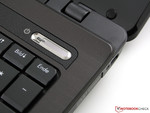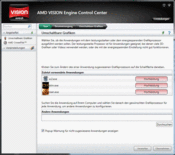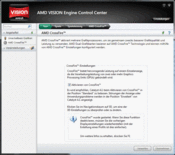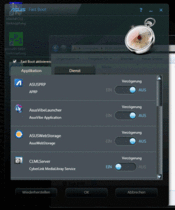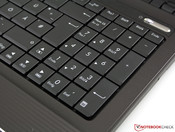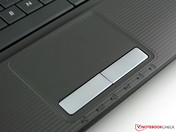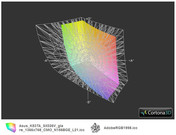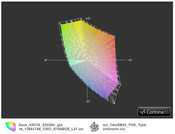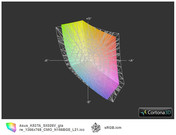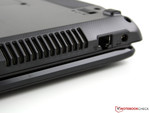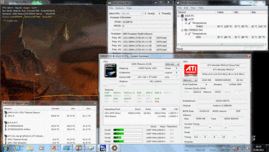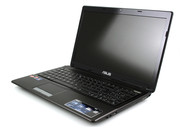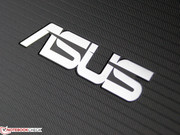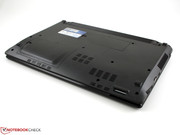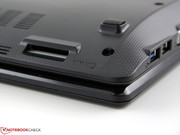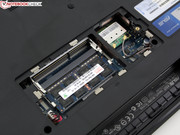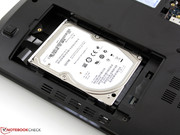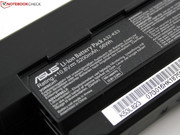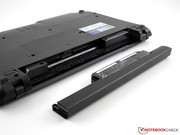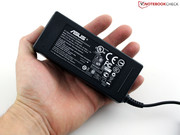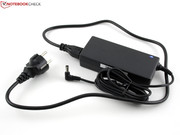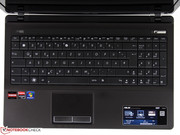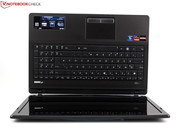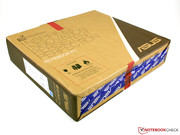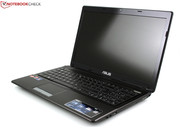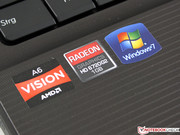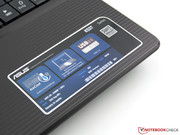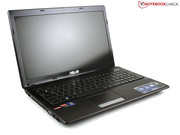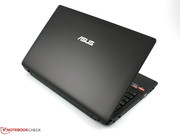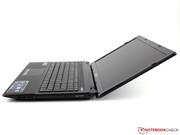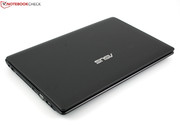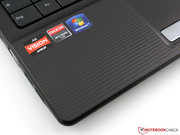Review Asus K53TA-SX026V (Fusion) Notebook

After the AMD Llano APU’s successful showing in our review of the Samsung Series 3 305V5A-S01DE, we turn excitedly to this 15.6-inch Asus K53TA-SX026V with almost identical hardware. Does the GPU Crossfire system provide good gaming performance, as it does in the Samsung model? Find out everything you need to know about the 500 Euro AMD Fusion notebook in this review.
Case
The case of the K53TA is just as suitable for the workplace as it is for the bedroom of a teenage gamer. The inside surfaces are comfortable and non-slip, which will please office typers; the patterning on the palm rest is perhaps a little slippery, but it doesn’t pick up fingerprints.
The case gives the laptop a high-quality appearance, with no uneven spacing between parts. But as soon as we pick up the 15.6-inch machine, we notice its weak points: the lid and chassis. We can make both parts flex significantly between our two hands. The palm rest remains firm, as does the keyboard.
The hinges are tight and hold the lid safely in position; it does not tend to wobble following adjustment. The hinges sit firmly in their mounting. The maximum opening angle of around 145 degrees is more than enough for using it on your lap.
The underside of the laptop, made of a patterned plastic, can only be made to flex with one finger above the DVD drive. The two access panels give you the option of replacing your hard drive, RAM or WLAN module.
Connectivity
The Asus K53TA-SX026V has a limited amount of ports for attaching peripherals. E-SATA and ExpressCard are luxuries that the K53TA cannot offer - but in fact it doesn’t really need them; because the notebook has a USB 3.0 port, so the user is well equipped for the next few years.
There are only three USB ports altogether. The two ports on the left are positioned too closely together. Wider USB sticks or angled connectors will get in each other’s way. It is a shame that the laptop’s hinges are embedded so deeply that they prevent the use of the back edge for ports, which would theoretically be possible. Bulky connectors, like VGA or HDMI, are bunched up on the left-hand side (visible area).
Communication
The Atheros wireless card (AR9285) supports the fastest Draft-N standard of WLAN. The manufacturer has decided to do without an integrated Bluetooth module. The appropriate Ethernet card, in the form of the Realtek Gigabit Ethernet adaptor, is provided for anyone wanting to connect the laptop to a Gigabit switch at home.
Accessories
The manufacturer does not include a Windows recovery DVD or driver CD in the box. You are supposed to burn the appropriate disks yourself using the AI Recovery tool.
Warranty
A 24-month manufacturer’s warranty is commendable in the case of this budget laptop. Manufacturers like HP, Lenovo, and Acer only offer 12 months for this price class.
Input Devices
Keyboard
The keyboard is a success, apart from the squashed-up arrow keys. The number pad has the standard format (four rows). The keys offer sufficient feedback and travel. The typing feel is firm, because the surface sits securely in almost every area. The sole exception is a small area above the DVD drive. In this place the keyboard flexes just a little. We did find the keys’ lack of curvature to be annoying. It causes a certain amount of inaccuracy when typing, because your fingers find it hard to orientate themselves.
Touchpad
The large touchpad (10.4 cm diameter) sits flush with the palm rest and is made of the same material (but smooth). The difference in texture means that can find the touchpad without looking. The touchpad (an Elan Smart Pad) feels slippy to use and is at times a little imprecise. Some people may feel that it lacks traction.
There is a multi-touch option for recognising two-finger gestures like scrolling or zooming for instance. The alternative of a vertical and horizontal scrollbar (one-finger scrolling) has been done away with! The touchpad buttons give minimal feedback and make a very loud, cheap-sounding ‘click’ when pressed.
Display
So the Asus K53TA’s input devices have set the bar quite low. It’s the same story when it comes to the display. The reflective CMO panel (type N156BGE-L2) has a resolution of 1,366 x 768. This WXGA resolution is still the standard for 15-inch machines. The 1,366 x 768 pixels are very close to having a 16:9 aspect ratio.
The CMO panel’s weak point is its poor contrast ratio of 181:1. Buyers with high expectations for colour fidelity - who want vibrant colours, to put it simply - will have to invest significantly more money than this, because good displays are few and far between. The glossy finish appears to improve the poor contrast, but this is actually a superficial effect that fools the eyes.
It would be desirable to have better contrast for reproducing colours in films, pictures and games. The small colour space of the Vaio EB4X demonstrates that even higher-end machines with Full HD resolution do not necessarily have a broad colour space.
| |||||||||||||||||||||||||
Brightness Distribution: 84 %
Center on Battery: 210 cd/m²
Contrast: 181:1 (Black: 1.16 cd/m²)
56% AdobeRGB 1998 (Argyll 3D)
80.8% sRGB (Argyll 3D)
54.3% Display P3 (Argyll 3D)
The 15.6-inch screen’s LED backlighting helps it to an average brightness of 201 cd/m². This is sufficient for indoor use, but in sunlight it naturally becomes difficult or even impossible for the screen to outshine the reflections that appear. The photos we took were on a day with only gentle sunshine, which is why you can still make out the test picture quite well in places. The distribution of brightness is only moderately even. The brightest and darkest areas are separated by about 35 cd/m², which is not yet noticeable with the naked eye.
A notebook needs good viewing angles so that users can still clearly make out colours and text when viewing from the side or from above at a constant level of brightness. For multimedia notebooks this is a crucial demand, but one that is very seldom met. The K53TA’s viewing angles are poor. Horizontally, the eyes can only deviate by 40% before the screen starts to darken and the colours invert. Vertically, the effect begins after only the slightest change in angle.
Performance
Inside the Asus K53TA is an AMD Fusion APU A series A6-3400M (1.4 - 2.3 GHz) processor with four cores. An energy-efficient HD 6520G is integrated into it, identified only as HD 6500 (name of the series) by Hardware Tools. The laptop also has an HD 6650M (Tools: HD 6500) as a dedicated graphics unit. The combination is called Dual Graphics HD 6720G (spec sheet).
The K10 processing cores can be overclocked, hence the specification of a GHz bandwidth (Turbo Core 2.0). For details see AMD: Llano APUs officially unveiled and the CPU spec sheet. Compared to the A6-3410MX APU (1.6 - 2.3 GHz), also a quad-core, the TDP is lower: 35 Watts (rather than 45). In addition to all this you get a 5,400 rpm Seagate hard drive (500 GB) and four GB of RAM (1x 4 GB).
CPU Performance
The Cinebench R11.5 CPU test (multi-core) finished on 1.79 points. The sister-APU A6-3410MX (Samsung 305V5A) managed 2.0 points (+13%). This means the CPU part of the APU is even inferior to the smallest Core i3-2310M (2.0 points). An i5 is even faster, for instance the 2410M (2.3 GHz, Turbo Boost) which scores 2.6 points. The R11.5 test is absolutely typical; the other CPU tests (wprime, R10) also suggest performance at a level slightly below that of a current Core i3.
The CPU’s Turbo speed is 2.3 GHz according to the spec sheet. But with all Fusion systems, the GPU has priority; this means that when the GPU is under stress, the CPU speed is restricted in favour of the GPU TDP. It may be down to the imprecision of Tools, but the speed of a single core never exceeded 2.0 GHz during our testing. Even this figure was only touched on for a fraction of a second (it would be better to say 1.8 GHz).
The screenshots show CPU usage with/ without concurrent GPU usage. What is interesting is that during gaming, the speed is limited to 800 MHz. A Cinebench R11.5 CPU benchmark which was run alongside the game was not able to raise the speed. Even once the game had ended, Cinebench had to be started up again before it could enjoy the use of 1.5 GHz. The results of the gaming tests, however, do not show any drop in performance, in fact quite the opposite at times.
| Cinebench R11.5 - CPU Multi 64Bit (sort by value) | |
| Asus K53TA-SX026V | |
| Toshiba Tecra R850-11P | |
| HP Pavilion dv6-6110eg | |
| Lenovo ThinkPad L520 NWB53GE | |
In the PCMark Vantage benchmark, the Fusion system manages 3,808 points. The sister-APU the 3410MX (Samsung 305V5A) reaches 4,873 points with somewhat more speed (1.6 instead of 1.4 GHz x 4) and a faster hard drive (HDD score: 3,224 instead of 2,733). As with the pure CPU performance, this puts our quad-core Fusion system quite some way behind the Core i3 (Samsung 200B5B-S01DE, 2310M, 4,874) and i5 laptops (Asus X53E-SX082V, 2410M, HD 3000, 4,887).
In the PCMark 7 our test system scored 1,542 points (Samsung 305V5A: 1,562). Here, the most recent Futuremark test seems to take the higher GPU performance into account, making up for the hard drive and the slower clock speed. This means the i3 competition is not so far ahead anymore: compare with the Vostro 3350 (1,751 points), Asus U30SD (1,772 points), and ProBook 4530s (1,921 points).
| PCMark Vantage Result | 3808 points | |
| PCMark 7 Score | 1542 points | |
Help | ||
GPU Performance
The HD 6650M in our Fusion notebook can only partly be said to offer the same performance as the HD 6650M in the Packard Bell EasyNote LS11-HR-050GE (600/900, core/memory speed) or in the Sony Vaio VPC-Z21Q9E (600/900). The reason for this is the different speeds (600/900 here) and their being combined with powerful Intel CPUs. The Crossfire option in our review model makes a comparison virtually impossible. Some games/ benchmarks are boosted by it, while some negate its benefits.
We look then at that constant of the benchmarking world, the 3DMark06, which gives a score of 6,186 points. An Nvidia GT 540M scores 8,000 points here on average, and a (rare) HD 6650M makes it to 7,250 points (in the EasyNote LS11). For the games and the synthetic benchmarks, Crossfire was always activated. A 3DMark06 test without Crossfire ended on an identical 6,145/ 2,148 points (score/ CPU value).
The 3DMark Vantage (P) benchmark ended its run-through on 3,864 points. The HD 6470M in the Samsung 305V5A managed only 3,224 points. The Geforce GT 540M produces an average of 4,400 points (Intel CPU). Incidentally, the review model was running Catalyst 8.861.0.0.
A 3DMark 11 test ended on P1,404/ G1,439 points, where the score without Crossfire was about 40% lower. This boost puts the Asus K53TA level with or above laptops with singular powerful GPUs: GT 550M (1,107; Asus N53SN), HD 6770M (1,407; HP Pavilion dv7-6101eg) or the GT 540 (1,023; Samsung RF511). The fastest GT 540M system reached a score of 1,033 points only through the help of a 2630QM quad-core in the 3DMark 11 test (Sony Vaio VPC-F21Z1E/BI).
In the AMD Vision Engine Control Center, every application has to be explicitly assigned to the energy-saving HD 6520G or the more powerful graphics unit (HD 6550M).
| 3DMark 06 Standard Score | 6186 points | |
| 3DMark Vantage P Result | 3864 points | |
| 3DMark 11 Performance | 1404 points | |
Help | ||
The K53TA-SX026V has a 5,400 rpm hard drive made by Seagate. The 500 GB HDD 9ST9500325AS) reads at a rate of 65 MB/s in the drive’s sequential read data. That figure is relatively average. This is partly to blame for the comparatively weak system performance as reflected in the PCMark Vantage test. The HDD can be heard making some background noise and a soft clattering while in use.
Gaming Performance
The Radeon HD 6720G2 Dual Graphics, the name given to this combination of HD 6520G and HD 6550M, acquitted itself very well in our gaming tests. AMD have put a stop to the bluescreen crashes seen previously and the Crossfire throttling in an HP Pavilion dv6-6110eg (Llano), which were caused by driver problems. The phenomenon of micro-stuttering during Crossfire use did not stand out negatively in any of the test games. However, stuttering could clearly be seen during the 3DMark Vantage benchmark.
Gaming Verdict
The gaming tests ran with the dual graphics system without any driver issues; Crossfire was always activated (standard settings). For Battlefield: Bad Company 2 and StarCraft 2 we tested the effect of Crossfire. Only Battlefield enjoyed 8 additional fps through Crossfire.
The good gaming results are striking, showing the AMD Radeon HD 6720G2 ‘package’ to be as good as (Dirt 3, Risen) or better than (Battlefield) a ‘faster’ single Nvidia GT 540M. But, StarCraft 2 (-10%) and Deus Ex HR (-34%) run better on the Nvidia GPU.
With these changeable results, gamers will still prefer a mid-range Geforce GT 540M. Here, the buyer is on the safe side without Crossfire on/off. The HD 6720G2 is definitely to be preferred to the HD 6680G2 (6470M) (Samsung 305V5A).
| low | med. | high | ultra | |
|---|---|---|---|---|
| Risen (2009) | 47.5 | 30.8 | 23.4 | |
| Battlefield: Bad Company 2 (2010) | 53.1 | 46 | 38 | |
| StarCraft 2 (2010) | 71.5 | 31.9 | 26.1 | |
| Dirt 3 (2011) | 40 | 35.3 | ||
| Deus Ex Human Revolution (2011) | 65.4 | 28 |
Emissions
System noise
For measuring the volume, we chose the Power4Gear Quiet Office mode. But this had no effect on the fan speed in idle; the fan purred along constantly and did not switch off. The 32.8 dB(A) that we measured, however, was not caused by the fan, but was the result of the comparatively loud background noise coming from the hard drive. When surfing the net, copying or writing emails, the fan runs at clearly differentiated levels of speed. These range from 33 to 35 dB(A).
With a constant heavy load on the processor (multi-core) provided by a CPU benchmark, the cooling system speeds up and gets as loud as 40 dB(A). The fan remains constant at its chosen speed. Only once we moved on to the computer games did the cooling system rise to its maximum 44 dB(A). Even the standard stress test, in which both the GPU and the CPU run at full load at the same time, could only produce the aforementioned 40 dB(A).
Noise level
| Idle |
| 32.8 / 33.4 / 34.7 dB(A) |
| HDD |
| 33.2 dB(A) |
| DVD |
| 38.3 / dB(A) |
| Load |
| 39.8 / 44 dB(A) |
 | ||
30 dB silent 40 dB(A) audible 50 dB(A) loud |
||
min: | ||
Temperature
Asus K series laptops have one thing in common: the IceCool design of the base unit. The chassis is supposed to have a special construction which keeps the palm rest and keyboard cool. We could confirm this for this review model; the touchpad warmed up to 34 degrees at its maximum.
When we measured during the heavy system demands (stress test) we found an average of only 29 degrees on the upper side of the laptop. On the underside too, you can only feel warmth in the area directly around the air outlet vent. This area is only lukewarm at 37 degrees.
Behaviour under Stress
The energy consumption during the stress test is considerably less than during a computer game. The reason for this could be drivers that are optimised for games.
Furmark+Prime95: 45 W; Furmark: 35 W; 3DMark06: 47 W
BFBC2: 66 W; Risen: 52 W; Deus Ex HR: 50 W; StarCraft2: 59 W
The variable CPU speed via TurboCore 2.0 allows the four A6-3400M cores to adjust their speed as needed. The screenshots show two heavy-use scenarios. Our finding: with simultaneous GPU stress, the speed of individual cores sinks briefly to 1,000 MHz. Four cores working simultaneously fluctuate between 1.0 and 1.4 GHz (Prime Solo) or work relatively constantly at 1.5 GHz (Cinebench multi-core tests).
(+) The maximum temperature on the upper side is 35.3 °C / 96 F, compared to the average of 36.9 °C / 98 F, ranging from 21.1 to 71 °C for the class Multimedia.
(+) The bottom heats up to a maximum of 37.4 °C / 99 F, compared to the average of 39.2 °C / 103 F
(+) In idle usage, the average temperature for the upper side is 26.1 °C / 79 F, compared to the device average of 31.3 °C / 88 F.
(+) The palmrests and touchpad are reaching skin temperature as a maximum (33.5 °C / 92.3 F) and are therefore not hot.
(-) The average temperature of the palmrest area of similar devices was 28.7 °C / 83.7 F (-4.8 °C / -8.6 F).
Speakers
The two loudspeakers above the keyboard favour the higher frequencies, whilst neglecting mid and low tones. For gamers or music lovers, these speakers are unusable, and so it will be essential to use external speakers. The maximum volume is sufficient, but not particularly high. The sound quality remains free of scratches or distortions throughout.
Battery life
The very long battery life on idle (no stress, lowest brightness setting) points to a low energy consumption. Our measurements confirmed that. The lowest energy use in idle ranged from only 10 Watts up to 16 Watts (minimum and maximum in idle, with no recharging).
The stress test (Prime95, Furmark), does not tempt the Fusion system out of its shell, as we remarked earlier in the Behaviour under Stress section: 45 Watts. But during games the system’s energy demands can reach between 50 and 66 Watts. The 90-Watt mains adaptor (372 g) is therefore suitable designed. It even leaves up to 30 Watts of leeway for recharging the battery.
| Off / Standby | |
| Idle | |
| Load |
|
Key:
min: | |
The six-cell lithium ion battery with its 56 Wh capacity provides excellent battery life. The K53TA lasted for five hours during WLAN internet surfing. If you want to watch DVD films when on the go, it will last for up to 3:36 hours. However, the recharging time required is extremely long at 4 hours (Samsung 305V5A: 2:00 hours).
The Llano notebook Samsung 305V5A only lasted for 3:26 hours in the WLAN test (dual GPU, but 45 W TDP). The HP Pavilion dv6-6110eg (dual GPU, Llano) managed 4:38 hours with its 55 Wh battery. Intel-based machines, like the Asus X43SV, reach 3:34 hours with Core i5 and GT 540M (56 Wh battery).
Verdict
AMD’s Llano A series APU (A6-3400M, dual GPU with HD 6720G2) lives up to its promise: good gaming performance in a 500 Euro notebook. Our test games ran quickly, often on high details and in the native HD resolution. The Radeon HD 6680G2 in the Samsung Serie 3 305V5A-S01DE (AMD Llano with HD 6470M) was either just beaten or was beaten by some margin.
The AMD project is coupled with a good battery life (5 hours) and a low energy consumption (idle: 10 Watts). But because of the poor glare-type display with its weak viewing angles and contrast, the low-quality input devices and the comparatively small number of ports (but USB 3.0!), the final grade that we can award is only a weak ‘good’.
For 499 Euros at present, the K53TA-SX026V’s gaming performance is commendable, but not unique. From Nvidia there is the GeForce GT 540M, which has already broken the 500 Euro barrier in a few laptops. One such is the Acer Aspire 5750G with the latest Core i3 (variations).




